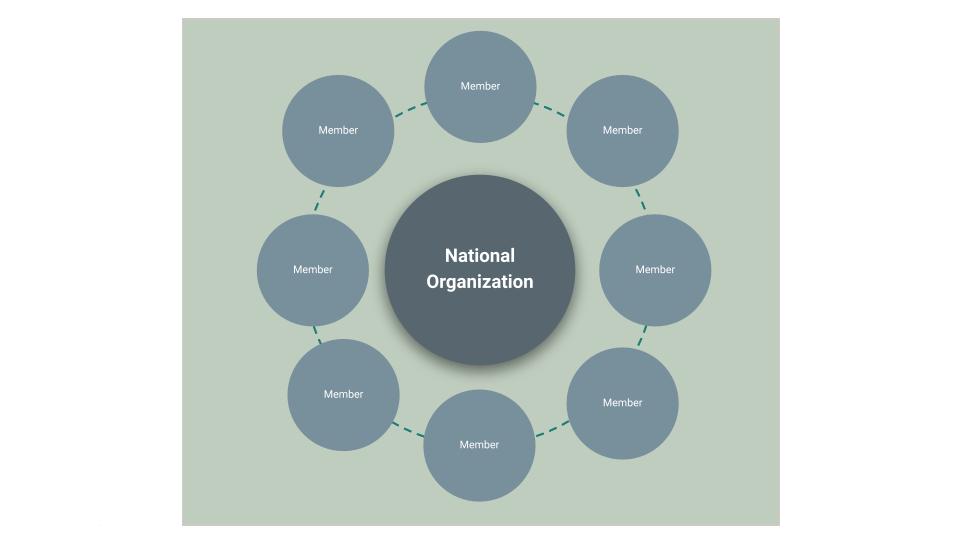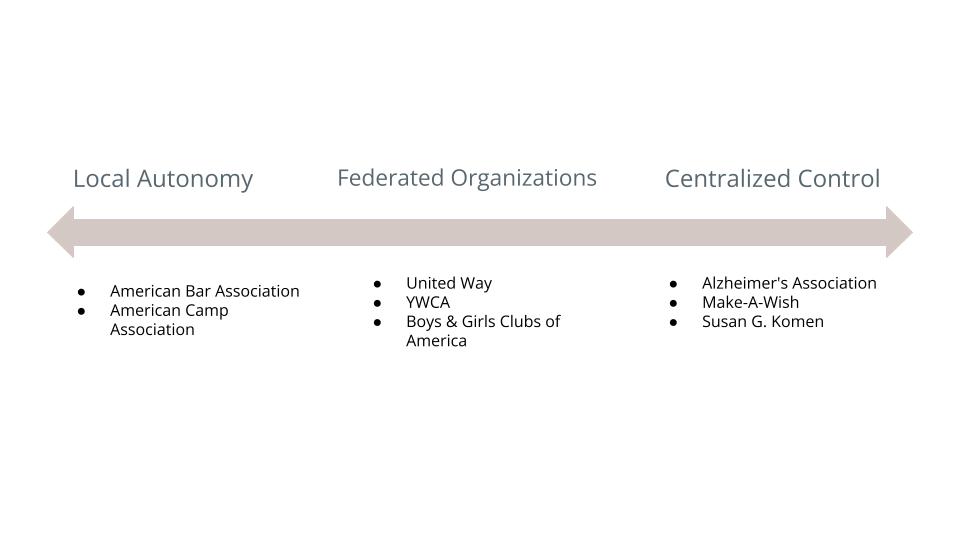Nonprofit networks, or federated organizations, are groups of organizations that are independent, but united under the same mission: think Habitat for Humanity, Feeding America, United Way and the Y-USA.
In a nonprofit network, there is typically a national (or international) organization, and then there are locally-based, independently run nonprofits, often called members, affiliates or partners that share the same (or similar) brand and mission.
In this article, we’ll use the terms: nonprofit network, national organization and members.
Nonprofit Networks

The national organization typically serves its members and the members provide direct services at the local level. For example, Boys & Girls Clubs of America is the national organization, and Boys & Girls Clubs of Chicago is a member (in this instance it’s called a Club) that serves youth in Chicago.
Whether you are part of a national organization that serves members or you work at a nonprofit that is a member within a nonprofit network, learning about the benefits and challenges of the structure can bring clarity to your role and how you support the mission.
Why operate as a nonprofit network?
Some of the United States’ largest and oldest nonprofits are part of nonprofit networks, and there are a number of benefits to operating in this structure. Some include:
- Increased brand recognition and credibility
- National reach with local presence, which allows the network to more effectively participate in advocacy and replicate models that have been successful, while still centering the needs of each local community where a member is located
- Economies of scale or efficiencies in things like HR, technology, programs, services, etc.
- Opportunities for collaboration, resource-sharing, peer-to-peer engagement and learning that can help individual members more quickly solve problems or capitalize on opportunities
What does the national organization do as part of a nonprofit network?
The national organization of a nonprofit network does many things in service of members. Some of the things national organizations commonly do include:
- Setting network-wide standards, policies and procedures
- Maintaining the brand. This means creating brand guidelines and ensuring the proper usage of things like the logo, language and visual identity across the nonprofit network and beyond.
- Fundraising and granting. National organizations will often run large-scale fundraising campaigns to gain funding that local members likely could not get on their own. This funding can also be distributed to network members through grants. Additionally, national organizations will provide fundraising support or fundraise in partnership with local members.
- Commissioning research to support brand building, advocacy and education about the importance of the mission
- Advocating and supporting state and federal policies, activating local members as necessary
- Facilitating collaboration across the network. National organizations often create opportunities for formal and informal collaboration, including town hall meetings, annual conferences, and direct connections between network members.
- Providing resources for nonprofit network members. This can include access to technology platforms, outside consultants, tools and templates as well as education.
- Consulting, including strategic planning, marketing and fundraising support
- Programmatic support
“By mobilizing resources outside their immediate control, networked nonprofits achieve their missions far more efficiently, effectively, and sustainably than they could have by working alone.” – The Networked Nonprofit, Stanford Social Innovation Review
Local autonomy versus centralized control
The relationship between the national organization and its members varies from nonprofit network to nonprofit network. There are nonprofits where organizations come together under a centralized mission, but they are loosely affiliated. Think of associations, like the American Bar Association or the American Camp Association, as examples of this. In the case of the American Camp Association, each member camp is its own organization, has its own brand and mission, but joins the American Camp Association in its mission to enrich the lives of children, youth and adults through the camp experience.
Then there are nonprofit networks that operate similar to franchises (yes, think like McDonald’s, Goldfish Swim Schools or Great Harvest Bread). All maintain the same brand and mission, receive resources and support from a national entity, but operate independently on the ground within their communities or regions. This category includes United Way, YWCA and Boys & Girls Clubs.
Finally, there are nonprofit networks that operate more with chapters, like the Alzheimer’s Association, Make-A-Wish and Susan G. Komen.

Commonly held challenges of nonprofit networks
In our work with nonprofit networks, one of the most common challenges we see is confusion about the relationship between the national office and its members, leading to confusion about who is responsible for what.
Sometimes network members feel the national organization takes too much credit for their work when describing it in marketing or fundraising materials or does not clearly differentiate between their role as the national organization and the work of members who are providing direct service.
In nonprofit networks, there can also be a sense from members that the national organization does not understand the work or their communities as well as they do, and therefore members can undervalue some of the expertise or resources the national organization brings. This can also lead to members questioning the overall value of the national organization.
Decision-making dynamics can be difficult for networked nonprofits. Clearly defining roles and responsibilities can help, but ultimately, the national office and the network must find ways of building consensus and working together to advance the network’s mission.
Evidence-based versus outcomes-based nonprofit network models
In addition to clearly defining the roles of the national organization and members, overcoming the challenges of operating as a nonprofit network can also be supported through two approaches. According to the Bridgespan Group, which interviewed network leaders, nonprofit networks can anchor on measurable outcomes or an evidence-based approach.
Nonprofit networks that anchor on an outcomes-based model identify a handful of measurable outcomes and the national organization holds members of the network accountable for achieving those outcomes. Bridgespan gives an example of World Vision International, which identified four key indicators: looking at whether children were well-nourished, protected from disease, able to read at age 11 and had a self-assessed sense of wellbeing. To maintain accountability, each country or region sends a report on these targets to the international organization, and through a well-developed structure of knowledge sharing across the network, World Vision seeks to identify and spread best practices. Ahead of measuring the impact of these changes, the organization collected two years of baseline data to measure progress against.
Nonprofit networks that anchor on an evidence-based approach, identify evidence-based programs and offer them to members with support from the national organization to ensure adherence to the model. This is different than anchoring on outcomes as it prescribes a program, based on testing that has proven a certain approach works, versus targeting an outcome and asking members of a network to figure out how to achieve it.
Bridgespan provided the example of Y-USA, which had two proven programs, Y-Readers and BELL (Building Educated Leaders for Life). They replicated the internal Y-Readers program and created the Y’s new Power Scholars program, licensed and adapted from BELL. Then, they created a scaling strategy to “deliver the programs with fidelity, measure outcomes, and keep improving across a very diverse network.” According to the article, this required difficult changes — away from a model of local innovation to one of sticking to the models — but showed results. “Underperforming students gained two and a half months of reading skills and two and a half months of math skills.”
As you might imagine, nonprofit networks are complex. While everything starts with a shared mission, there must be clearly defined roles within the structure, as well as a healthy dose of trust and transparency to ensure they are effective and impactful. We will be digging more into the unique challenges and opportunities for nonprofit networks in the coming months.